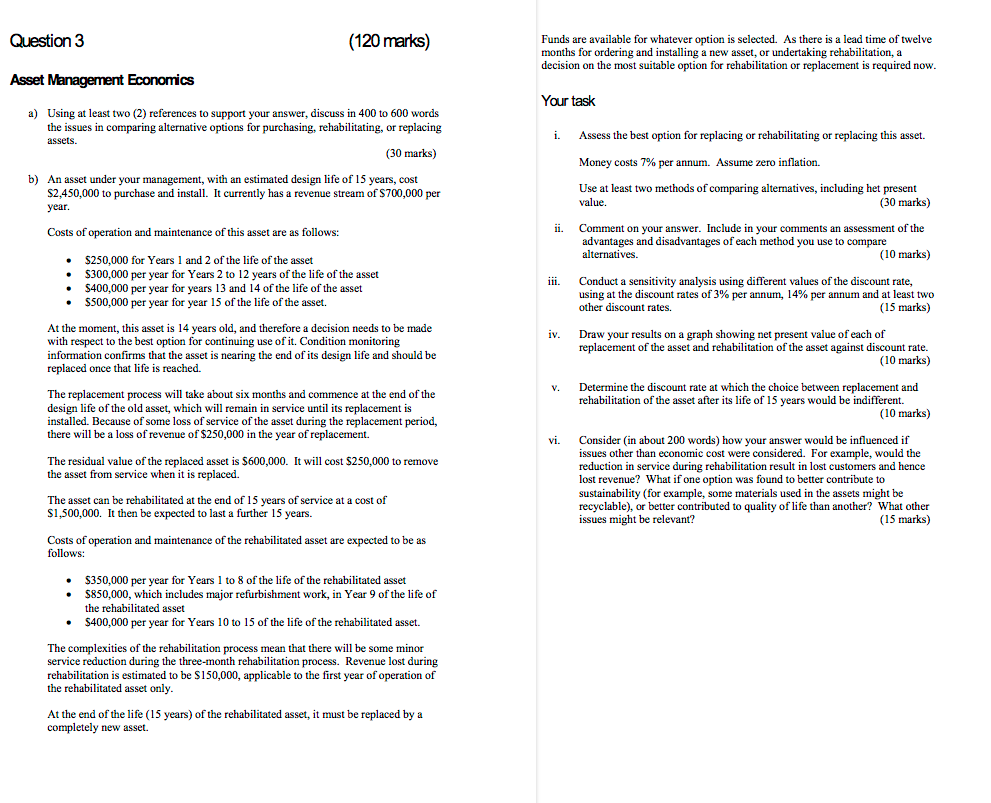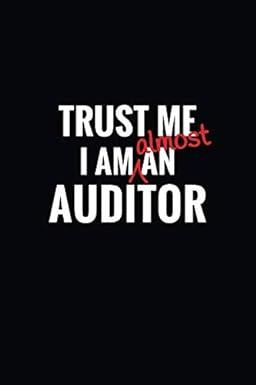 i need full answer ms word typed only question no 3
i need full answer ms word typed only question no 3
Asset Management Economics a) Using at least two (2) references to support your answer, discuss in 400 to 600 words the issues in comparing alternative options for purchasing, rehabilitating, or replacing assets b) An asset under your management, with an estimated design life of 15 years, cost $2, 450,000 to purchase and install. It currently has a revenue stream of $700,000 per year. Costs of operation and maintenance of this asset are as follows $250,000 for Years 1 and 2 of the life of the asset $300,000 per year for Years 2 to 12 years of the life of the asset $400,000 per year for years 13 and 14 of the life of the asset $500,000 per year for year 15 of the life of the asset At the moment, this asset is 14 years old, and therefore a decision needs to be made with respect to the best option for continuing use of it. Condition monitoring information confirms that the asset is nearing the end of its design life and should be replaced once that life is reached. The replacement process will take about six months and commence at the end of the design life of the old asset, which will remain in service until its replacement installed. Because of some loss of service of the asset during the replacement period, there will be a loss of revenue of $250,000 in the year of replacement. The residual value of the replaced asset is $600,000. It will cost $250,000 to remove the asset from service when it is replaced. The asset can be rehabilitated at the end of 15 years of service at a cost of $1, 500,000. It then be expected to last a further 15 years. Costs of operation and maintenance of the rehabilitated asset are expected to be as follows: $350,000 per year for Years 1 to 8 of the life of the rehabilitated asset $850,000, which includes major refurbishment work, in Year 9 of the life of the rehabilitated asset $400,000 per year for Years 10 to 15 of the life of the rehabilitated asset. The complexities of the rehabilitation process mean that there will be some minor service reduction during the three-month rehabilitation process. Revenue lost during rehabilitation is estimated to be $150,000, applicable to the first year of operation of the rehabilitated asset only. At the end of the life (15 years) of the rehabilitated asset, it must be replaced by a completely new asset. Funds are available for whatever option is selected. As there is a lead time of twelve months for ordering and installing a new asset, or undertaking rehabilitation, a decision on the most suitable option for rehabilitation or replacement is required now Your task i. Assess the best option for replacing or rehabilitating or replacing this asset. Money costs 7% per annum. Assume zero inflation. Use at least two methods of comparing alternatives, including het present value ii. Comment on your answer. Include in your comments an assessment of the advantages and disadvantages of each method you use to compare alternatives iii. Conduct a sensitivity analysis using different values of the discount rate, using at the discount rates of 3% per annum, 14% per annum and at least two other discount rates iv. Draw your results on a graph showing net present value of each of replacement of the asset and rehabilitation of the asset against discount rate. v. Determine the discount rate at which the choice between replacement and rehabilitation of the asset after its life of 15 years would be indifferent. vi. Consider (in about 200 words) how your answer would be influenced if issues other than economic cost were considered. For example, would the reduction in service during rehabilitation result in lost customers and hence lost revenue? What if one option was found to better contribute to sustainability (for example some materials used in the assets might be recyclable), or better contributed to quality of life than another? What other issues might be relevant? Asset Management Economics a) Using at least two (2) references to support your answer, discuss in 400 to 600 words the issues in comparing alternative options for purchasing, rehabilitating, or replacing assets b) An asset under your management, with an estimated design life of 15 years, cost $2, 450,000 to purchase and install. It currently has a revenue stream of $700,000 per year. Costs of operation and maintenance of this asset are as follows $250,000 for Years 1 and 2 of the life of the asset $300,000 per year for Years 2 to 12 years of the life of the asset $400,000 per year for years 13 and 14 of the life of the asset $500,000 per year for year 15 of the life of the asset At the moment, this asset is 14 years old, and therefore a decision needs to be made with respect to the best option for continuing use of it. Condition monitoring information confirms that the asset is nearing the end of its design life and should be replaced once that life is reached. The replacement process will take about six months and commence at the end of the design life of the old asset, which will remain in service until its replacement installed. Because of some loss of service of the asset during the replacement period, there will be a loss of revenue of $250,000 in the year of replacement. The residual value of the replaced asset is $600,000. It will cost $250,000 to remove the asset from service when it is replaced. The asset can be rehabilitated at the end of 15 years of service at a cost of $1, 500,000. It then be expected to last a further 15 years. Costs of operation and maintenance of the rehabilitated asset are expected to be as follows: $350,000 per year for Years 1 to 8 of the life of the rehabilitated asset $850,000, which includes major refurbishment work, in Year 9 of the life of the rehabilitated asset $400,000 per year for Years 10 to 15 of the life of the rehabilitated asset. The complexities of the rehabilitation process mean that there will be some minor service reduction during the three-month rehabilitation process. Revenue lost during rehabilitation is estimated to be $150,000, applicable to the first year of operation of the rehabilitated asset only. At the end of the life (15 years) of the rehabilitated asset, it must be replaced by a completely new asset. Funds are available for whatever option is selected. As there is a lead time of twelve months for ordering and installing a new asset, or undertaking rehabilitation, a decision on the most suitable option for rehabilitation or replacement is required now Your task i. Assess the best option for replacing or rehabilitating or replacing this asset. Money costs 7% per annum. Assume zero inflation. Use at least two methods of comparing alternatives, including het present value ii. Comment on your answer. Include in your comments an assessment of the advantages and disadvantages of each method you use to compare alternatives iii. Conduct a sensitivity analysis using different values of the discount rate, using at the discount rates of 3% per annum, 14% per annum and at least two other discount rates iv. Draw your results on a graph showing net present value of each of replacement of the asset and rehabilitation of the asset against discount rate. v. Determine the discount rate at which the choice between replacement and rehabilitation of the asset after its life of 15 years would be indifferent. vi. Consider (in about 200 words) how your answer would be influenced if issues other than economic cost were considered. For example, would the reduction in service during rehabilitation result in lost customers and hence lost revenue? What if one option was found to better contribute to sustainability (for example some materials used in the assets might be recyclable), or better contributed to quality of life than another? What other issues might be relevant
 i need full answer ms word typed only question no 3
i need full answer ms word typed only question no 3





